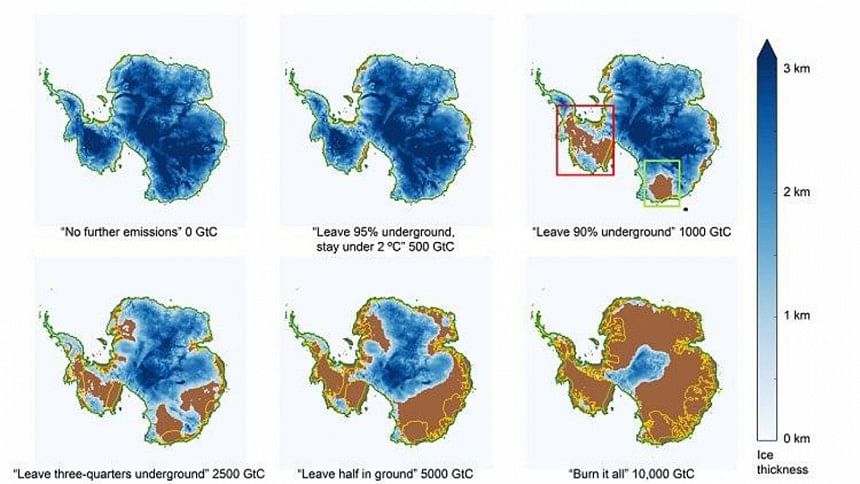All of Antarctica might melt, drowning major cities

A group of researches believe that the fossil fuels still in the ground are sufficient to eliminate the Antarctic Ice Sheet and ultimately cause as much as 200 feet of sea level rise.
Few peer-reviewed study titles sound quite so much like a line spoken by the bad-news-bearing scientist from a dystopian sci-fi movie. But there it is. A real-world—and apparently very possible—dystopia, reports Newsweek.
Ken Caldeira, a climate scientist at the Carnegie Institution for Science, believes is the first time, he and his colleagues have shown that there are enough fossil fuels still in the ground to melt "effectively all of Antarctica" and ultimately cause as much as 200 feet of sea level rise.
He and his colleagues Friday published the paper in this regard in the journal Science Advances.
Of course, it wouldn't be only Antarctica that melts under this scenario, Caldeira says adding, "Our study shows that if we don't leave most of the carbon in the ground, we are going to melt most of the ice on this planet. I think this is one of the most important papers of my career."

This chart shows how Antarctic ice would be affected by different emissions scenarios. "GTC" stands for gigatons of carbon, Ken Caldeira and Ricarda Winkelmann said.
The paper takes a long view at the planet's worst-case scenario. The UN's Intergovernmental Panel on Climate Change (IPCC) already estimates that sea levels will rise between 2 and 3 feet by the end of this century. That may well be correct, Caldeira says.
But he and his colleagues chose to ask the natural follow-up: What happens after this century? The short answer: The world will continue to warm, and sea level rise will begin to speed up, at least for the next 1,000 years, reports the American weekly.
"Our results indicate that once Antarctica really starts melting, sea level rise could exceed 1 foot per decade," amounting to about 100 feet of sea level rise over the following 1,000 years, Caldeira says. "That is quite a clip."
After 10,000 years, under a "burn it all" scenario, the sea will rise by as much as 200 feet, the news magazine reported.
"It is one thing to say, 'We can deal with 2 or 3 feet of sea level rise.' It is another thing entirely to discuss when we will be forced to abandon New York, London, Paris, Rome, Washington, etc.," Caldeira says.
An Adelie penguin stands atop a block of melting ice near the French station at Dumont d'Urville in East Antarctica January 23, 2010.
The global average temperature, at that point, will be around 9 degrees Celsius (roughly 16 degrees Fahrenheit) higher than it is today. That is not a climate scenario under which many things would survive.
Experts have already called the possibility of exceeding 2 degrees Celsius warming "dangerous," and 4 degrees Celsius warming a "catastrophic" scenario. A world that is 9 degrees Celsius hotter would likely be unrecognizable and perhaps even uninhabitable.
Other research has charted out melt scenarios for other ice sheets, like the Greenland ice sheet, and has focused on the quickly disintegrating West Antarctic ice sheet. But the East Antarctic ice sheet is far larger, which means it has much more ice that can melt and contribute to sea level rise. Taken together, the potential sea level rise from all of Antarctica "far exceeds that of all other possible sources," the paper reads.
"The West Antarctic ice sheet may already have tipped into a state of unstoppable ice loss, whether as a result of human activity or not. But if we want to pass on cities like Tokyo, Hong Kong, Shanghai, Calcutta, Hamburg and New York as our future heritage, we need to avoid a tipping in East Antarctica," Ricarda Winkelmann, of the Postdam Institute for Climate Impact Research and another author on the study, said in a statement.
Caldeira emphasizes that their results are based on big-picture known variables, like the fact that once the world warms, it stays hot for a long time. That doesn't leave much room for skepticism, he says.
"If our result depended on tiny details, then I would be skeptical. But in the case we consider, the Earth gets quite hot and stays quite hot a long time. If the Earth stays hot a long time, the ice will melt. I do not believe this result will be sensitive to minor variations in how ice models are put together," Caldeira says. Their paper shows, quite simply, that "[u]nrestrained fossil fuel burning means giving up many if not most of the major cities of the world. It means giving up Florida."
"Hopefully, our study will help people realize that there is great benefit to rapidly transforming our energy system into one that does not rely on using the sky as a waste dump."

 For all latest news, follow The Daily Star's Google News channel.
For all latest news, follow The Daily Star's Google News channel. 



Comments